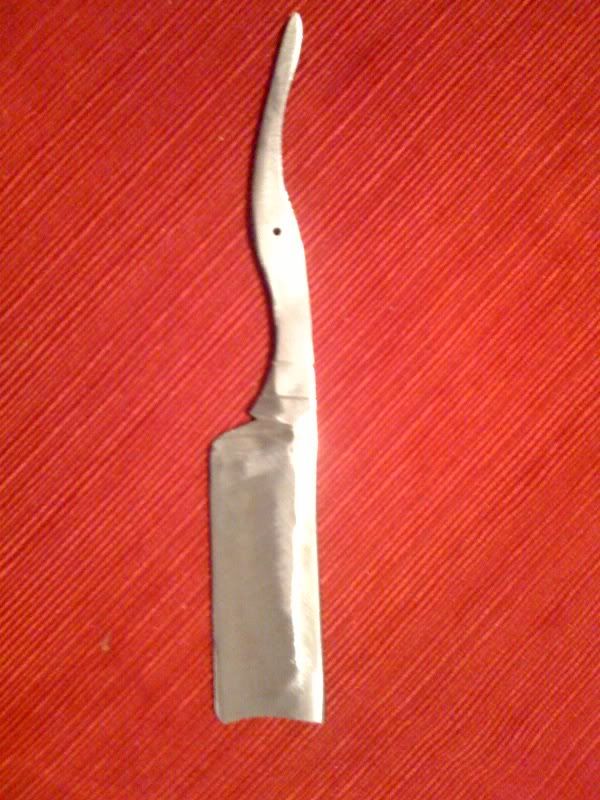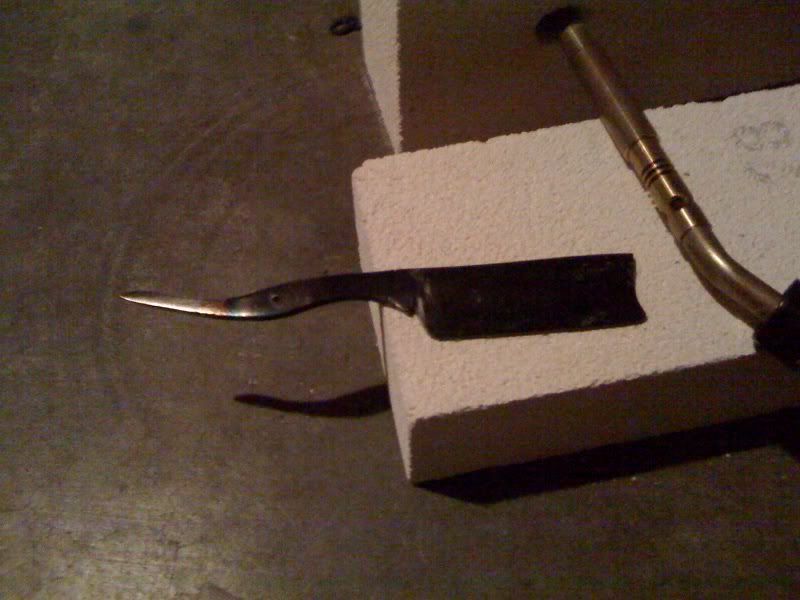Results 1 to 10 of 143
Thread: An experiment in steel
Hybrid View
-
12-31-2009, 04:51 AM #1

I am too late but did you consider giving the steel that will
be the cutting edge a good peening before you finish grind it?
Hot or cold forging can improve the grain of the steel.
Visit some smithing sites... here is a link to shot peening.
Shot peening - Wikipedia, the free encyclopedia
I should note that some modern steel has already been hammered
and rolled to a point that this is not a requirement.
-
12-31-2009, 05:06 AM #2Senior Member

- Join Date
- Jan 2008
- Posts
- 701
Thanked: 182
false
hammering a blade will not noticeably change anything but matter of fact will build up stress in the steel (that should be relieved in heat treat anyhow)
most steel that you get will have been forged in rolling mills down from blocks more then a foot thick (let me know what ta guy with a hammer is doing other then shaping ot his needs)
the true fixing of grain is in the heat and cycles there of (most of would not need fixing if not over heated in the forging processes )
-
12-31-2009, 06:17 PM #3"My words are of iron..."


- Join Date
- Oct 2006
- Posts
- 1,898
Thanked: 995
Butch, there is a provable change in grain size from forging techniques. While there has been considerable horse exhaust spread about this process in many different directions, it does, and will refine grain. It would not have persisted as a smithing technique for several hundreds of years if it did not work. Plus work hardening was performed on how many millions of perfectly serviceable copper and bronze blades long before iron and steel came along.
Tossing out the baby with the bathwater is never a good idea. I do not argue against there being better ways to get the job done, and refine the grain over the whole blade, not just the edge, as you've alluded to with thermal cycling. Perhaps a more efficient smith will use more efficient methods, but it doesn't mean that history is worthless or should be condemned out of hand.
Mike: "packing" is probably better referred to as finish forging where you're attempting to refine the surface features of a blade while the temperature is falling through the decalescence range of temperature, where, coincidentally, grain formation is at its most active and likely to be best influenced by mechanical reduction. I've met any number of European smiths who were taught to forge everything, so as to leave any grinding or filing to a minimum. Their technique is impressive. It makes my skill with a hammer look childish to be honest.
But, when I made a blade and they did according to their methods, and I thermal cycled mine and we broke both blades, they were full of all kinds of questions. Like "Show me that again..." There is no doubt in my mind that better techniques will catch the attention of a craftsman everytime.
Where packing went off course, so to speak, is when folks started explaining it as moving atoms closer together. If that were true, then smithy's should be easier to identify from the residual radiation and cratering.... “Nothing discloses real character like the use of power. Most people can bear adversity. But if you wish to know what a man really is, give him power.” R.G.Ingersoll
“Nothing discloses real character like the use of power. Most people can bear adversity. But if you wish to know what a man really is, give him power.” R.G.Ingersoll
-
12-31-2009, 07:38 PM #4Senior Member

- Join Date
- Jan 2008
- Posts
- 701
Thanked: 182
ok so not total but to put copper and bronze i the same kind of work hardening is a bit over the top. let me know how well cold working steel gets you to a usable hardness

but yes there has been much garbage put out about edge packing but one has to remember that steel is more like working crystals not atoms
kind of like sugar
depending on the temp you take sugar to you can make taffy or hard candy called tempering
all in all the debat will rage on and for the best of it will help get more and more out of the steel we use by making us all try different thing and testign
-
12-31-2009, 09:14 PM #5"My words are of iron..."


- Join Date
- Oct 2006
- Posts
- 1,898
Thanked: 995
I didn't say copper and bronze were the same as iron or steel. Even though the history books say they were Bronze Age or Iron Age, there was considerable overlap of the types of materials used in blades during both time periods.
The ancient metalworkers who had the knowledge of how to work copper or bronze would have tried them out on the iron and steel as well. For that matter, there are some museum bronze blades that are harder than iron blades from the same time period as a result of work hardening.
Last time I dug around in the work-hardening materials book, it was possible to bring a manganese steel up to about 600 Brinnell from work hardening alone. It helps if it's a work-hardening steel like this, but even steels without manganese will harden some from cold deformation.
Here's the conversion chart: Maryland Metrics: Hardness Conversion Chart You have to figure out for yourself it's a useable hardness.“Nothing discloses real character like the use of power. Most people can bear adversity. But if you wish to know what a man really is, give him power.” R.G.Ingersoll
-
01-01-2010, 05:38 AM #6

Regardless, the information here is looking good.
My question is: can I make a decent razor with a bare bones setup.
and all of you are helping.
Hopefully I will be ready to do my heat treat in the next few days, I almost have a forge made...
and next comes the finish work.
I don't expect to make a Zowada or a Williams, but if I can shave with it, this experiment will be a success.
-
01-01-2010, 06:15 AM #7Senior Member

- Join Date
- Jan 2008
- Posts
- 701
Thanked: 182
your good
dont worry keep the shop dark adn wait for ther shadows to dance on first run just pull out the steel
the 2nd run watch hotthe steel comes up to teml
and whe you see the shodows dance give a sec and then pull and quench
with yur edge being waht it is i can only hope for you but if you have a 2nd blank thats a hair thicker then i feel there ias hope
-
01-04-2010, 01:27 AM #8


second blade almost ready... much thicker than #1
My furnace is done, and I will post it's picture next...

-
01-04-2010, 04:41 AM #9

Heat treat done on blade #2
had to play with my torch a bit to get the heat even
brought the blade up to a bright red/orange/non-magnetic
quenched in peanut oil
no flare no warping nice and clean
I couldn't get the tail up to heat in my forge though... Too small
I'll do the other blade tomorrow


Last edited by Mike_ratliff; 01-04-2010 at 04:46 AM.


 LinkBack URL
LinkBack URL About LinkBacks
About LinkBacks








 Reply With Quote
Reply With Quote
